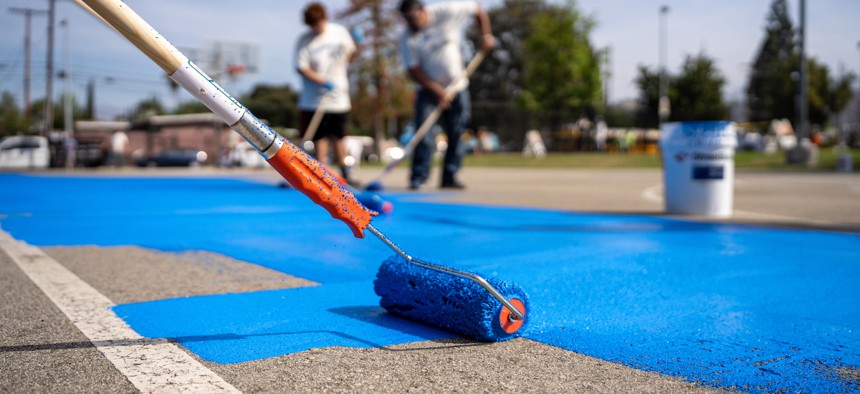One city takes to the streets to address extreme heat

Photo courtesy of GAF
A Los Angeles neighborhood tested the impact of an innovative cool pavement coating, and research shows it holds potential to supplement climate mitigation efforts.
A little over a month into spring, climate experts are already projecting that the summer of 2024 will be hotter than usual. The rise in temperatures in recent years doesn’t seem to be coming down anytime soon, and it’s prompting governments at all levels to find ways to help keep their communities cool.
The National Weather Service, for instance, just released a new HeatRisk index that can warn Americans of expected extreme heat up to a week in advance. The site aims to help residents prepare for hot conditions, which can have major health impacts like inducing a fatal heat stroke or aggravating asthma. At the state and local level, governments are exploring a range of solutions like cultivating tree canopies and opening cooling centers to protect residents against extreme heat. But some communities are addressing the issue from the ground up—literally.
Take Pacoima, California, which is located in the San Fernando Valley just north of Los Angeles and considered one of the city’s hottest neighborhoods. The community has disparate tree coverage and an abundance of pavement, contributing to a high incidence of urban heat islands, which worsen air quality and increase health risks. Plus, the effects on the neighborhood’s population of largely low-income people of color reinforces inequities and disparities in climate resilience.
To try to lessen the impact of extreme heat, in the summer of 2022 Pacoima partnered with the climate advocacy nonprofit Climate Resolve and roofing and waterproofing manufacturer GAF to analyze the impact of its cool pavement product. That July, GAF helped install its cool pavement coating to about 700,000 square feet of the neighborhood’s roads, playgrounds and parking lots.
Most other asphalt-based cool pavement treatments add a lot of white pigment to make them solar reflective, said Eliot Wall, senior director of pavement solutions of GAF. And while this approach to reflectivity can help reduce asphalt pavement’s heat-capturing qualities, it can also have unintended consequences like making passersby feel hotter when they are on top of the coating or creating a glare that can impede drivers’ ability to focus on the road.
Ultimately for extending pavement life, “[with asphalt-based coatings] you’re protecting asphalt with asphalt, which is a really bad idea,” Wall said. “It’s like if you had a wood roof. You don’t just put on more wood and expect it to be waterproof, right?”
That’s why GAF wanted to test its acrylic-based sealcoat, or protective coating, in Pacoima, Wall said. The coating reflects near-infrared light that goes undetected by human eyes and is comparable in durability to standard road sealants, but thinner than most coatings.
Scientists collected data on the acrylic-based coating for a year using an electric golf cart, a drone, satellites and local weather stations to record thermal imagery and temperature data. And a study released last month shows that it’s working. Data showed the cool pavement contributed to surface temperature reductions of up to 10 degrees, and a decrease in ambient air temperatures by about 3.5 degrees during extreme heat events like the heatwave that hit the neighborhood in September 2022.
The study of census tract data also found Pacoima saw a 20% to 50% reduction in the urban heat island effect during temperature peaks. Plus, data suggested the cool pavement did not have a significant impact on temperature during winter months, meaning homeowners and building operators don’t have to crank up the heat to offset the coating’s effects, said Jonathan Parfrey, executive director of Climate Resolve.
The technology can be a time- and cost-effective way to mitigate the impacts of extreme weather as communities build up their climate resilience, Wall said, as it’s comparable in cost to existing pavement maintenance solutions. Plus, applying a reflective coating on public roads and surfaces can help officials cool down an entire neighborhood in one fell swoop, Parfrey said.
Community reaction to the cool pavement was overwhelmingly positive, he added. Residents reported that they could spend more time outside, and neighborhood basketball players said the cool pavement court didn’t break down their shoes or basketballs as quickly as the traditional surface. Street vendors also reported that they prefer working in areas with cool pavement because employees can stay out and sell their goods for longer.
Cooler temperatures can get people outside where they can be more engaged with their built environment and their neighbors. Those experiences build resident and stakeholder support for climate mitigation efforts because “climate solutions are human solutions,” Parfrey said.
However, cool pavement is not a silver bullet, he said. Municipalities must still invest in other climate solutions for a comprehensive approach to worsening climate change effects.
Editor's Note: This story was updated April 25 to clarify comments from Eliot Wall.






